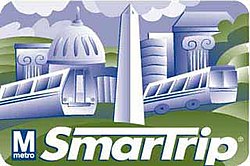 | |
| Location | Baltimore–Washington metropolitan area |
|---|---|
| Launched | May 18, 1999 |
| Technology |
|
| Operator | |
| Manager | Washington Metropolitan Area Transit Authority |
| Currency | USD ($300 maximum load) |
| Validity | |
| Retailed |
|
| Variants |
|
| Website | https://www.smartrip.com/ |
SmarTrip is a contactless stored-value smart card payment system managed by the Washington Metropolitan Area Transit Authority (WMATA). The Maryland Transit Administration (MTA) uses a compatible payment system called CharmCard. A reciprocity agreement between the MTA and WMATA allows either card to be used for travel on any of the participating transit systems in the Baltimore-Washington metropolitan area. Unlike traditional paper farecards or bus passes, SmarTrip/CharmCard is designed to be permanent and reloadable; the term "SmarTrip" may refer to both payment systems unless otherwise noted.
WMATA began using SmarTrip for payment on Metrorail in 1999 followed shortly by Metrobus and Metro parking lots. It was later extended to other public transit systems throughout the region. Although WMATA initially drew criticism due to the limited number of SmarTrip sales locations, distribution has expanded to local convenience stores and supermarkets. By late 2012 all Metrorail stations were equipped with SmarTrip vending machines.[1]
In October 2010, WMATA announced that it was working on a replacement card system because the company that makes SmarTrip cards had stopped producing the existing generation.[2] A new generation of the card with modernized chip technology was launched in 2012.[3] Beginning in 2021, the first-generation SmarTrip cards are being phased out as new faregates are installed that do not support the earlier technology.[4]
In 2014, WMATA began a pilot program with Accenture to revamp the SmarTrip payments, with the goal of an open payment system working with contactless credit cards, government IDs, new transit cards, and more. However, the pilot was terminated and the full proposal was cancelled due to lower-than-expected mobile payment adoption and budget constraints.[5]
Instead, in 2018, WMATA announced that contactless mobile payments would be coming to Metro, this time through a closed system that emulates the physical smart card and works with current fare collection equipment. The reduced scope of the project lowered costs dramatically, while constraining users to loading a balance on a SmarTrip account instead of paying directly from a credit/debit card.[5] Mobile payments through Apple Pay were added in 2020, with Google Pay support following in 2021.[6][7]
Since March 6, 2016, SmarTrip cards are the only payment method accepted on Metrorail; paper farecards are no longer valid.[8]
- ^ Lazo, Luz (November 6, 2012). "All Metro stations now have SmarTrip vending machines". The Washington Post. Archived from the original on December 14, 2018. Retrieved September 12, 2017.
- ^ Schultz, David (October 15, 2010). "Metro Board: Replacing SmarTrip Will Be Difficult". WAMU. Archived from the original on December 17, 2014. Retrieved February 5, 2012.
- ^ Weir, Kytja (May 28, 2012). "Metro to get new, cheaper SmarTrip cards this fall". Washington Examiner. Archived from the original on May 30, 2012. Retrieved May 29, 2012.
- ^ "Metro begins phasing out older SmarTrip cards as part of upgrades to faregates and fare payment technology | WMATA". www.wmata.com. Archived from the original on July 9, 2021. Retrieved July 7, 2021.
- ^ a b Repetski, Stephen (April 17, 2018). "Metro Reasons: Metro hopes to bring mobile and phone payments by 2019". ggwash.org. Archived from the original on November 12, 2020. Retrieved July 7, 2021.
- ^ Cite error: The named reference
:2was invoked but never defined (see the help page). - ^ Cite error: The named reference
:3was invoked but never defined (see the help page). - ^ "Paper Farecard Elimination". Archived from the original on December 24, 2016. Retrieved March 4, 2016.
